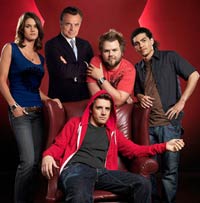 Don’t get me wrong, “Prince Caspian,” the second of Disney’s movie remakes of C.S. Lewis’s Chronicles of Narnia novels is pure fun, an old-fashioned tale of a wicked uncle who usurps a throne, only to be overthrown by his goodly nephew—Caspian himself, with the help of talking animals and some swashbuckling strangers.
Don’t get me wrong, “Prince Caspian,” the second of Disney’s movie remakes of C.S. Lewis’s Chronicles of Narnia novels is pure fun, an old-fashioned tale of a wicked uncle who usurps a throne, only to be overthrown by his goodly nephew—Caspian himself, with the help of talking animals and some swashbuckling strangers.
Director Andrew Adamson knows how to breathe life into this classic material, too. The swordfights are suspenseful, the effects cheesily magnificent and neither the sweaty chases nor the intricately planned attacks always go as you expect. In a Hollywood first, even the dwarf is funny.
But it’s also the most Christian movie your kids will drag you to this year.
The first tale in the Narnia series, “The Lion, the Witch and the Wardrobe,” is an allegorical retelling of the cosmic battle between Jesus and Satan, as told in John’s gospel, with a dual ending: first the ritual execution of the lion-god Aslan on the mythical Stone Table, then his resurrection. That movie almost necessarily ended up as a blend of Dr. Doolittle and “The Passion of the Christ.”
Lewis’s “Caspian” is a more delicate, and stranger, brew, and Disney could have easily judged that the public’s appetite for Judeo-Christian topics had been satisfied, not only by the first movie in the series, but “Evan Almighty” and other biblical films set loose by Mel Gibson’s successful “Passion.” Set a year in our time and 1,300 years in Narnian time after the first book, “Caspian” takes the four Pevensie children, Lucy, Edmond, Susan, and Peter, back to their erstwhile kingdom to install Caspian as king of Narnia.
The hitch is that Caspian is a Telmarine, one of the race of invaders who have dominated Narnia for centuries, driving the magic of the forest into remission. The surviving— the talking beasts, dwarves, centaurs, and the like—don’t like the idea of a Telmarine king, and Miraz, Caspian’s uncle, doesn’t like the idea of a challenger to the throne.
The faith parallel for all this is rather obscure: Lewis is recalling the battles in the early church between those who thought Christ was a uniquely Jewish messiah, and those (who eventually prevailed) who believed he had come to save all people, Roman, Greek, Syrian, or Jew. This factional strife raised questions for the early church about how Christians were to persevere without the physical presence, and leadership, of Jesus.
Disney might have ignored all this, confident they could depend on “The Lion, the Witch and the Wardrobe’s” big box office. Instead “Caspian” gives Lewis, and Jesus, his due. Peter Pevensie, in a moment of doubt about his abilities as High King, shows how the questions of the early church still apply to Christians today. “I wish he would show himself to me,” Peter says to his sister Lucy about the Christ figure Aslan. “Just to prove that he’s there.” Lucy replies, in a typical retort of Lewis’s: “Maybe it’s us who need to prove ourselves to him.”
It could be, of course, that Disney believes that most audiences will do the ignoring for them, happy to come along for the CGI ride. More likely, “Caspian” is the strongest indication yet that spirituality is just one more flavor that Americans expect to imbibe at their local cinema.


